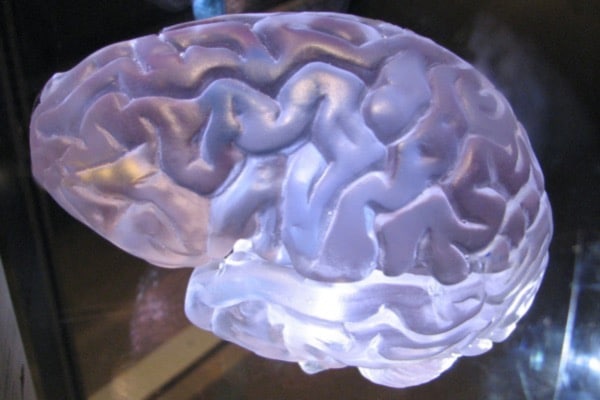Here’s a theory: Alzheimer’s biomarker beta-amyloid could — rather than killing the brain — actually be trying to defend it.
Here’s a theory: Alzheimer’s biomarker beta-amyloid could — rather than killing the brain — actually be trying to defend it. The provocative idea builds on a growing body of research. Some scientists are taking it one step farther, looking into whether increasing the levels of this protein could treat Alzheimer’s.
For the last few decades, one protein has been in the crosshairs of Alzheimer’s research: beta-amyloid. Since people who have an early-onset form of Alzheimer’s develop beta-amyloid plaques early in life — coinciding with their cognitive decline — it became the prime suspect for causing Alzheimer’s disease.
Although scientists have developed many drugs to clear beta-amyloid in the brain, these drugs have failed to halt the progression of Alzheimer’s, calling this hypothesis into question. Even a year after a high-profile drug called Aduhelm — the first-ever disease-modifying drug for Alzheimer’s — received FDA approval, there still isn’t enough evidence to determine whether the drug works.
One camp of scientists is positing a theory for why the beta-amyloid hypothesis has not been proven. What if clearing beta-amyloid doesn’t halt disease progression? What if, instead, it protect the brain?
Bruno Imbimbo, a researcher and Alzheimer’s drug developer at the pharmaceutical company Chiesi Farmaceutici, wrote a provocative editorial in the journal Pharmacological Research, suggesting this idea.
Considering a long list of failed Alzheimer’s drugs, Imbimbo points to a class of drugs called secretase inhibitors, which prevent beta-amyloid from being produced in the first place. He points out that, when tested against Alzheimer’s, these drugs actually appeared to worsen cognitive performance.
“Both g-secretase and b-secretase inhibitors, which strongly inhibit amyloid-beta production, worsen cognitive and clinical performance in early and late stages of Alzheimer’s disease,” he told Being Patient. “B-secretase inhibitors have been shown to worsen cognitive performance even in unimpaired participants at risk of developing Alzheimer’s disease.”
Instead of clearing beta-amyloid, he said, treatments for Alzheimer’s disease may need to increase the amount of this “good” beta-amyloid in the brain.
What is beta-amyloid and what does it do in the brain?
Karl Herrup, a professor of neurobiology at the University of Pittsburgh, told Being Patient that while beta-amyloid is well known as an Alzheimer’s biomarker, it remains largely a mystery. He remains one of the most outspoken critics of the beta-amyloid hypothesis, and is the author of How Not to Study A Disease. Recently, he took to Twitter to compile other researchers’ thoughts about the role of beta-amyloid.
Herrup and Imbimbo told Being Patient about the many proposed roles of this protein, which include regulating learning and memory, making new blood vessels, growing new brain cells, promoting recovery from injury, and acting as an antimicrobial agent.
“We actually know very little about the normal function of beta-amyloid,” Herrup said of this list of beta-amyloid’s unproven roles in the body. “None of these stories is well fleshed out, so we are mostly in the dark.”
Beta-amyloid proteins are produced when a secretase protein “cuts” a chunk off of the amyloid precursor protein. These smaller chunks are soluble, meaning they dissolve in the fluid between individual brain cells. When these proteins aggregate and stick to each other, they form plaques, brain cells begin to malfunction, and the characteristic symptoms — memory loss, difficulty concentrating, trouble with everyday tasks — progressively get more severe.
While this evidence could support the idea that beta-amyloid may cause the development of Alzheimer’s disease, scientists say, it could also support the idea that beta-amyloid is trying to compensate for the damage caused by Alzheimer’s disease.
Increasing the levels of soluble beta-amyloid
Beta-amyloid proteins are like paper clips. When multiple beta-amyloid proteins are connected together like string of paper clips, they are more likely to clump up, forming plaques. Beta-amyloid proteins that aren’t clumped into plaques are soluble, like sugar in water, they can dissolve into the cerebrospinal fluid that surrounds the brain. Low levels of these soluble proteins in this fluid are linked to increased levels of an aggregated form of beta-amyloid in the brain and cell death in both healthy older individuals and Alzheimer’s patients.
Imbimbo’s commentary suggests that when beta-amyloid proteins aggregate, they lose their normal neuroprotective function. This might explain recent failures in beta-amyloid plaque-clearing drugs which failed to improve cognition: The problem isn’t the plaques themselves, but rather a lack of soluble proteins available to protect the brain against the root cause of Alzheimer’s disease.
“If the anti-microbial idea [that beta-amyloid responds to infection in the brain] is correct this could indirectly protect cognition too,” Herrup said.”No one has gotten any traction with promoting this idea in the field.” Imbimbo himself is not currently developing any such drugs.
Increasing the levels of protective soluble beta-amyloid proteins may be a fascinating new approach for developing drugs to treat Alzheimer’s. But first, scientists and patients alike will eagerly await the results of the next few anti-amyloid drugs in the pipeline — whose final results will be submitted to the Food and Drug Administrator and evaluated by early next year.




